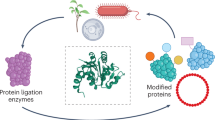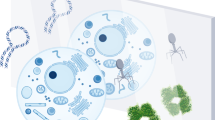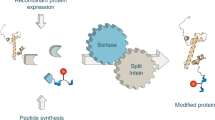Abstract
Methods to prepare proteins that include a specific modification at a desired position are essential for understanding their cellular functions and physical properties in living systems. Chemical protein synthesis, which relies on the chemoselective ligation of unprotected peptides, enables the preparation of modified proteins that are not easily fabricated by other methods. In contrast to recombinant approaches, chemical synthesis can be used to prepare protein analogues such as D-proteins, which are useful in protein structure determination and the discovery of novel therapeutics. Post-translationally modifying proteins is another example where chemical protein synthesis proved itself as a powerful approach for preparing samples with high homogeneity and in workable quantities. In this Review, we discuss the basic principles of the field, focusing on novel chemoselective peptide ligation approaches such as native chemical ligation and the recent advances based on this method with a proven record of success in the synthesis of highly important protein targets.
This is a preview of subscription content, access via your institution
Access options
Subscribe to this journal
Receive 12 print issues and online access
$259.00 per year
only $21.58 per issue
Buy this article
- Purchase on Springer Link
- Instant access to full article PDF
Prices may be subject to local taxes which are calculated during checkout







Similar content being viewed by others
References
Pattabiraman, V. R. & Bode, J. W. Rethinking amide bond synthesis. Nature 480, 471–479 (2011).
Kent, S. B. Chemical synthesis of peptides and proteins. Annu. Rev. Biochem. 57, 957–989 (1988).
Dawson, P. E., Muir, T. W., Clark-Lewis, I. & Kent, S. B. Synthesis of proteins by native chemical ligation. Science 266, 776–779 (1994).
Hackenberger, C. P. & Schwarzer, D. Chemoselective ligation and modification strategies for peptides and proteins. Angew. Chem. Int. Ed. 47, 10030–10074 (2008).
Siman, P. & Brik, A. Chemical and semisynthesis of posttranslationally modified proteins. Org. Biomol. Chem. 10, 5684–5697 (2012).
Mandal, K. et al. Chemical synthesis and X-ray structure of a heterochiral {D-protein antagonist plus vascular endothelial growth factor} protein complex by racemic crystallography. Proc. Natl Acad. Sci. USA 109, 14779–14784 (2012).
Yeates, T. O. & Kent, S. B. Racemic protein crystallography. Annu. Rev. Biophys. 41, 41–61 (2012).
Muir, T. W. Semisynthesis of proteins by expressed protein ligation. Annu. Rev. Biochem. 72, 249–289 (2003).
Durek, T. & Becker, C. F. W. Protein semi-synthesis: new proteins for functional and structural studies. Biomol. Eng. 22, 153–172 (2005).
Johnson, E. C. & Kent, S. B. Insights into the mechanism and catalysis of the native chemical ligation reaction. J. Am. Chem. Soc. 128, 6640–6646 (2006).
Bang, D., Pentelute, B. L. & Kent, S. B. H. Kinetically controlled ligation for the convergent chemical synthesis of proteins. Angew. Chem. Int. Ed. 45, 3985–3988 (2006).
Schnolzer, M., Alewood, P., Jones, A., Alewood, D. & Kent, S. B. H. In situ neutralization in Boc-chemistry solid phase peptide synthesis: rapid, high yield assembly of difficult sequences. Int. J. Pept. Res. Ther. 13, 31–44 (2007).
Kang, J. & Macmillan, D. Peptide and protein thioester synthesis via N→S acyl transfer. Org. Biomol. Chem. 8, 1993–2002 (2010).
Zheng, J. S., Tang, S., Huang, Y. C. & Liu, L. Development of new thioester equivalents for protein chemical synthesis. Acc. Chem. Res. 46, 2475–2484 (2013).
Blanco-Canosa, J. B. & Dawson, P. E. An efficient Fmoc-SPPS approach for the generation of thioester peptide precursors for use in native chemical ligation. Angew. Chem. Int. Ed. 47, 6851–6855 (2008).
Mahto, S. K., Howard, C. J., Shimko, J. C. & Ottesen, J. J. A reversible protection strategy to improve Fmoc-SPPS of peptide thioesters by the N-acylurea approach. ChemBioChem 12, 2488–2494 (2011).
Blanco-Canosa, J. B., Nardone, B., Albericio, F. & Dawson, P. E. Chemical protein synthesis using a second generation N-acylurea linker for the preparation of peptide-thioester precursors. J. Am. Chem. Soc. 137, 7197–7209 (2015).
Wang, P., Layfield, R., Landon, M., Mayer, R. J. & Ramage, R. Transfer active ester condensation: a novel technique for peptide segment coupling. Tetrahedron Lett. 39, 8711–8714 (1998).
Fang, G. M. et al. Protein chemical synthesis by ligation of peptide hydrazides. Angew. Chem. Int. Ed. 50, 7645–7649 (2011).
Siman, P., Karthikeyan, S. V., Nikolov, M., Fischle, W. & Brik, A. Convergent chemical synthesis of histone H2B protein for the site-specific ubiquitination at Lys34. Angew. Chem. Int. Ed. 52, 8059–8063 (2013).
Weinstock, M. T., Jacobsen, M. T. & Kay, M. S. Synthesis and folding of a mirror-image enzyme reveals ambidextrous chaperone activity. Proc. Natl Acad. Sci. USA 111, 11679–11684 (2014).
Fang, G. M., Wang, J. X. & Liu, L. Convergent chemical synthesis of proteins by ligation of peptide hydrazides. Angew. Chem. Int. Ed. 51, 10347–10350 (2012).
Hemantha, H. P. et al. Nonenzymatic polyubiquitination of expressed proteins. J. Am. Chem. Soc. 136, 2665–2673 (2014).
Shema-Yaacoby, E. et al. Systematic identification of proteins binding to chromatin-embedded ubiquitylated H2B reveals recruitment of SWI/SNF to regulate transcription. Cell Rep. 4, 601–608 (2013).
Ackrill, T., Anderson, D. W. & Macmillan, D. Towards biomolecular assembly employing extended native chemical ligation in combination with thioester synthesis using an N→S acyl shift. Biopolymers 94, 495–503 (2010).
Raibaut, L., Ollivier, N. & Melnyk, O. Sequential native peptide ligation strategies for total chemical protein synthesis. Chem. Soc. Rev. 41, 7001–7015 (2012).
Tsuda, S., Shigenaga, A., Bando, K. & Otaka, A. N→S Acyl-transfer-mediated synthesis of peptide thioesters using anilide derivatives. Org. Lett. 11, 823–826 (2009).
Hojo, H., Onuma, Y., Akimoto, Y., Nakahara, Y. & Nakahara, Y. N-alkyl cysteine-assisted thioesterification of peptides. Tetrahedron Lett. 48, 25–28 (2007).
Erlich, L. A., Kumar, K. S. A., Haj-Yahya, M., Dawson, P. E. & Brik, A. N-Methylcysteine-mediated total chemical synthesis of ubiquitin thioester. Org. Biomol. Chem. 8, 2392–2396 (2010).
Sato, K. et al. Chemical synthesis of biologically active monoglycosylated GM2-activator protein analogue using N-sulfanylethylanilide peptide. Angew. Chem. Int. Ed. 52, 7855–7859 (2013).
Kumar, K. S. et al. Total chemical synthesis of a 304 amino acid K48-linked tetraubiquitin protein. Angew. Chem. Int. Ed. 50, 6137–6141 (2011).
Bavikar, S. N. et al. Chemical synthesis of ubiquitinated peptides with varying lengths and types of ubiquitin chains to explore the activity of deubiquitinases. Angew. Chem. Int. Ed. 51, 758–763 (2012).
Ollivier, N., Dheur, J., Mhidia, R., Blanpain, A. & Melnyk, O. Bis(2-sulfanylethyl)amino native peptide ligation. Org. Lett. 12, 5238–5241 (2010).
Hou, W., Zhang, X. H., Li, F. P. & Liu, C. F. Peptidyl N,N-bis(2-mercaptoethyl)-amides as thioester precursors for native chemical ligation. Org. Lett. 13, 386–389 (2011).
Boll, E. et al. A novel PEG-based solid support enables the synthesis of >50 amino-acid peptide thioesters and the total synthesis of a functional SUMO-1 peptide conjugate. Chem. Sci. 5, 2017–2022 (2014).
Low, D. W., Hill, M. G., Carrasco, M. R., Kent, S. B. H. & Botti, P. Total synthesis of cytochrome b562 by native chemical ligation using a removable auxiliary. Proc. Natl Acad. Sci. USA 98, 6554–6559 (2001).
Offer, J., Boddy, C. N. C. & Dawson, P. E. Extending synthetic access to proteins with a removable acyl transfer auxiliary. J. Am. Chem. Soc. 124, 4642–4646 (2002).
Yan, L. Z. & Dawson, P. E. Synthesis of peptides and proteins without cysteine residues by native chemical ligation combined with desulfurization. J. Am. Chem. Soc. 123, 526–533 (2001).
Dawson, P. E. Native chemical ligation combined with desulfurization and deselenization: a general strategy for chemical protein synthesis. Isr. J. Chem. 51, 862–867 (2011).
Malins, L. R. & Payne, R. J. Synthetic amino acids for applications in peptide ligation–desulfurization chemistry. Aust. J. Chem. 68, 521–537 (2015).
Wan, Q. & Danishefsky, S. J. Free-radical-based, specific desulfurization of cysteine: a powerful advance in the synthesis of polypeptides and glycopolypeptides. Angew. Chem. Int. Ed. 46, 9248–9252 (2007).
Fauvet, B., Butterfield, S. M., Fuks, J., Brik, A. & Lashuel, H. A. One-pot total chemical synthesis of human α-synuclein. Chem. Commun. 49, 9254–9256 (2013).
Li, J. F. et al. Chemistry as an expanding resource in protein science: fully synthetic and fully active human parathyroid hormone-related protein (1–141). Angew. Chem. Int. Ed. 51, 12263–12267 (2012).
Creech, G. S., Paresi, C., Li, Y. M. & Danishefsky, S. J. Chemical synthesis of the ATAD2 bromodomain. Proc. Natl Acad. Sci. USA 111, 2891–2896 (2014).
Sakamoto, I. et al. Chemical synthesis of homogeneous human glycosyl-interferon-β that exhibits potent antitumor activity in vivo. J. Am. Chem. Soc. 134, 5428–5431 (2012).
Liu, S. H., Pentelute, B. L. & Kent, S. B. H. Convergent chemical synthesis of [lysine24, 38, 83] human erythropoietin. Angew. Chem. Int. Ed. 51, 993–999 (2012).
Wang, P. et al. At last: erythropoietin as a single glycoform. Angew. Chem. Int. Ed. 51, 11576–11584 (2012).
Murakami, M., Okamoto, R., Izumi, M. & Kajihara, Y. Chemical synthesis of an erythropoietin glycoform containing a complex-type disialyloligosaccharide. Angew. Chem. Int. Ed. 51, 3567–3572 (2012).
Wilson, R. M., Dong, S. W., Wang, P. & Danishefsky, S. J. The winding pathway to erythropoietin along the chemistry-biology frontier: a success at last. Angew. Chem. Int. Ed. 52, 7646–7665 (2013).
Wang, P. et al. Erythropoietin derived by chemical synthesis. Science 342, 1357–1360 (2013).
Kochendoerfer, G. G. et al. Design and chemical synthesis of a homogeneous polymer-modified erythropoiesis protein. Science 299, 884–887 (2003).
Kumar, K. S. A., Haj-Yahya, M., Olschewski, D., Lashuel, H. A. & Brik, A. Highly efficient and chemoselective peptide ubiquitylation. Angew. Chem. Int. Ed. 48, 8090–8094 (2009).
Spasser, L. & Brik, A. Chemistry and biology of the ubiquitin signal. Angew. Chem. Int. Ed. 51, 6840–6862 (2012).
Hendrickson, J. B. Systematic synthesis design. 6. Yield analysis and convergency. J. Am. Chem. Soc. 99, 5439–5450 (1977).
Wang, J. X. et al. Peptide o-aminoanilides as crypto-thioesters for protein chemical synthesis. Angew. Chem. Int. Ed. 54, 2194–2198 (2015).
Bang, D. & Kent, S. B. H. A one-pot total synthesis of crambin. Angew. Chem. Int. Ed. 43, 2534–2538 (2004).
Torbeev, V. Y. & Kent, S. B. H. Convergent chemical synthesis and crystal structure of a 203 amino acid “covalent dimer” HIV-1 protease enzyme molecule. Angew. Chem. Int. Ed. 46, 1667–1670 (2007).
Torbeev, V. Y. et al. Protein conformational dynamics in the mechanism of HIV-1 protease catalysis. Proc. Natl Acad. Sci. USA 108, 20982–20987 (2011).
Torbeev, V. Y. & Kent, S. B. H. Ionization state of the catalytic dyad Asp25/25′ in the HIV-1 protease: NMR studies of site-specifically 13C labelled HIV-1 protease prepared by total chemical synthesis. Org. Biomol. Chem. 10, 5887–5891 (2012).
Seenaiah, M., Jbara, M., Mali, S. M. & Brik, A. Convergent versus sequential protein synthesis: the case of ubiquitinated and glycosylated H2B. Angew. Chem. Int. Ed. 54, 12374–12378 (2015).
Rauk, A., Yu, D. & Armstrong, D. A. Oxidative damage to and by cysteine in proteins: an ab initio study of the radical structures, C–H, S–H, and C–C bond dissociation energies, and transition structures for H abstraction by thiyl radicals. J. Am. Chem. Soc. 120, 8848–8855 (1998).
Siman, P. et al. Chemical synthesis and expression of the HIV-1 Rev protein. Chembiochem 12, 1097–1104 (2011).
Moyal, T., Hemantha, H. P., Siman, P., Refua, M. & Brik, A. Highly efficient one-pot ligation and desulfurization. Chem. Sci. 4, 2496–2501 (2013).
Thompson, R. E. et al. Trifluoroethanethiol: an additive for efficient one-pot peptide ligation-desulfurization chemistry. J. Am. Chem. Soc. 136, 8161–8164 (2014).
Schmalisch, J. & Seitz, O. Acceleration of thiol additive-free native chemical ligation by intramolecular S→S acyl transfer. Chem. Commun. 51, 7554–7557 (2015).
Reimann, O., Smet-Nocca, C. & Hackenberger, C. P. Traceless purification and desulfurization of tau protein ligation products. Angew. Chem. Int. Ed. 54, 306–310 (2015).
Bondalapati, S. et al. Chemical synthesis of phosphorylated ubiquitin and diubiquitin exposes positional sensitivities of E1-E2 enzymes and deubiquitinases. Chem. Eur. J. 21, 7360–7364 (2015).
Canne, L. E. et al. Chemical protein synthesis by solid phase ligation of unprotected peptide segments. J. Am. Chem. Soc. 121, 8720–8727 (1999).
Brik, A., Keinan, E. & Dawson, P. E. Protein synthesis by solid-phase chemical ligation using a safety catch linker. J. Org. Chem. 65, 3829–3835 (2000).
Aucagne, V. et al. Towards the simplification of protein synthesis: iterative solid-supported ligations with concomitant purifications. Angew. Chem. Int. Ed. 51, 11320–11324 (2012).
Raibaut, L. et al. Highly efficient solid phase synthesis of large polypeptides by iterative ligations of bis(2-sulfanylethyl)amido (SEA) peptide segments. Chem. Sci. 4, 4061–4066 (2013).
Jbara, M., Seenaiah, M. & Brik, A. Solid phase chemical ligation employing a rink amide linker for the synthesis of histone H2B protein. Chem. Commun. 50, 12534–12537 (2014).
Tornoe, C. W. Christensen, C. & Meldal, M. Peptidotriazoles on solid phase: [1,2,3]-triazoles by regiospecific copper(I)-catalyzed 1,3-dipolar cycloadditions of terminal alkynes to azides. J. Org. Chem. 67, 3057–3064 (2002).
Nguyen, U. T. T. et al. Accelerated chromatin biochemistry using DNA-barcoded nucleosome libraries. Nature Methods 11, 834–840 (2014).
Ryadnov, M. G. & Woolfson, D. N. Self-assembled templates for polypeptide synthesis. J. Am. Chem. Soc. 129, 14074–14081 (2007).
Moyal, T., Bavikar, S. N., Karthikeyan, S. V., Hemantha, H. P. & Brik, A. Polymerization behavior of a bifunctional ubiquitin monomer as a function of the nucleophile site and folding conditions. J. Am. Chem. Soc. 134, 16085–16092 (2012).
Wilkinson, B. L. et al. Total synthesis of homogeneous antifreeze glycopeptides and glycoproteins. Angew. Chem. Int. Ed. 51, 3606–3610 (2012).
Tachibana, Y. et al. Antifreeze glycoproteins: elucidation of the structural motifs that are essential for antifreeze activity. Angew. Chem. Int. Ed. 43, 856–862 (2004).
Saxon, E., Armstrong, J. I. & Bertozzi, C. R. A “traceless” Staudinger ligation for the chemoselective synthesis of amide bonds. Org. Lett. 2, 2141–2143 (2000).
Nilsson, B. L., Kiessling, L. L. & Raines, R. T. Staudinger ligation: a peptide from a thioester and azide. Org. Lett. 2, 1939–1941 (2000).
Saito, F., Noda, H. & Bode, J. W. Critical evaluation and rate constants of chemoselective ligation reactions for stoichiometric conjugations in water. ACS Chem. Biol. 10, 1026–1033 (2015).
Zhang, Y. F., Xu, C., Lam, H. Y., Lee, C. L. & Li, X. C. Protein chemical synthesis by serine and threonine ligation. Proc. Natl Acad. Sci. USA 110, 6657–6662 (2013).
Bode, J. W., Fox, R. M. & Baucom, K. D. Chemoselective amide ligations by decarboxylative condensations of N-alkylhydroxylamines and α-ketoacids. Angew. Chem. Int. Ed. 45, 1248–1252 (2006).
Wucherpfennig, T. G., Pattabiraman, V. R., Limberg, F. R., Ruiz-Rodriguez, J. & Bode, J. W. Traceless preparation of C-terminal α-ketoacids for chemical protein synthesis by α-ketoacid-hydroxylamine ligation: synthesis of SUMO2/3. Angew. Chem. Int. Ed. 53, 12248–12252 (2014).
Pusterla, I. & Bode, J. W. An oxazetidine amino acid for chemical protein synthesis by rapid, serine-forming ligations. Nature Chem. 7, 668–672 (2015).
Noda, H., Eros, G. & Bode, J. W. Rapid ligations with equimolar reactants in water with the potassium acyltrifluoroborate (KAT) amide formation. J. Am. Chem. Soc. 136, 5611–5614 (2014).
Ohayon, S., Spasser, L., Aharoni, A. & Brik, A. Targeting deubiquitinases enabled by chemical synthesis of proteins. J. Am. Chem. Soc. 134, 3281–3289 (2012).
Wintermann, F. & Engelbrecht, S. Reconstitution of the Catalytic Core of F-ATPase (αβ)3γ from Escherichia coli using chemically synthesized subunit γ. Angew. Chem. Int. Ed. 52, 1309–1313 (2013).
Simon, M. D. et al. Rapid flow-based peptide synthesis. ChemBioChem 15, 713–720 (2014).
Kouzarides, T. Chromatin modifications and their function. Cell 128, 693–705 (2007).
Dheur, J., Ollivier, N. & Melnyk, O. Synthesis of thiazolidine thioester peptides and acceleration of native chemical ligation. Org. Lett. 13, 1560–1563 (2011).
Durek, T. & Alewood, P. F. Preformed selenoesters enable rapid native chemical ligation at intractable sites. Angew. Chem. Int. Ed. 50, 12042–12045 (2011).
Metanis, N., Keinan, E. & Dawson, P. E. Traceless ligation of cysteine peptides using selective deselenization. Angew. Chem. Int. Ed. 49, 7049–7053 (2010).
Mitchell, N. J. et al. Rapid additive-free selenocystine–selenoester peptide ligation. J. Am. Chem. Soc. 137, 14011–14014 (2015).
Malins, L. R., Mitchell, N. J., McGowan, S. & Payne, R. J. Oxidative deselenization of selenocysteine: applications for programmed ligation at serine. Angew. Chem. Int. Ed. 54, 12716–12721 (2015).
Dery, S. et al. Insights into the deselenization of selenocysteine into alanine and serine. Chem. Sci 6, 6207–6212 (2015).
Lahiri, S., Brehs, M., Olschewski, D. & Becker, C. F. W. Total chemical synthesis of an integral membrane enzyme: diacylglycerol kinase from Escherichia coli. Angew. Chem. Int. Ed. 50, 3988–3992 (2011).
Zheng, J. S. et al. Expedient total synthesis of small to medium-sized membrane proteins via Fmoc chemistry. J. Am. Chem. Soc. 136, 3695–3704 (2014).
Johnson, E. C. B. et al. Modular total chemical synthesis of a human immunodeficiency virus type 1 protease. J. Am. Chem. Soc. 129, 11480–11490 (2007).
Asahina, Y. et al. Chemical synthesis of O-glycosylated human interleukin-2 by the reverse polarity protection strategy. Angew. Chem. Int. Ed. 54, 8226–8230 (2015).
Rabideau, A. E., Liao, X. L. & Pentelute, B. L. Delivery of mirror image polypeptides into cells. Chem. Sci. 6, 648–653 (2015).
David, Y., Vila-Perello, M., Verma, S. & Muir, T. W. Chemical tagging and customizing of cellular chromatin states using ultrafast trans-splicing inteins. Nature Chem. 7, 394–402 (2015).
Acknowledgements
We thank the Israel Science Foundation for financial support (A.B.). S.B. thanks the Israel Council of Higher Education for a fellowship under the PBC program. A.B. is a Neubauer Professor and a Taub Fellow supported by the Taub Foundation.
Author information
Authors and Affiliations
Corresponding author
Ethics declarations
Competing interests
The authors declare no competing financial interests.
Rights and permissions
About this article
Cite this article
Bondalapati, S., Jbara, M. & Brik, A. Expanding the chemical toolbox for the synthesis of large and uniquely modified proteins. Nature Chem 8, 407–418 (2016). https://doi.org/10.1038/nchem.2476
Received:
Accepted:
Published:
Issue Date:
DOI: https://doi.org/10.1038/nchem.2476
This article is cited by
-
Synthesis and applications of mirror-image proteins
Nature Reviews Chemistry (2023)
-
Tobacco as green bioreactor for therapeutic protein production: latest breakthroughs and optimization strategies
Plant Growth Regulation (2023)
-
A prebiotically plausible scenario of an RNA–peptide world
Nature (2022)
-
Site-selective photocatalytic functionalization of peptides and proteins at selenocysteine
Nature Communications (2022)
-
General synthetic strategy for regioselective ultrafast formation of disulfide bonds in peptides and proteins
Nature Communications (2021)



